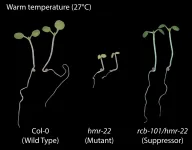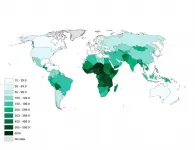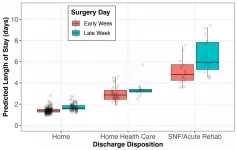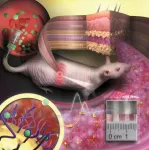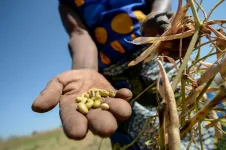(Press-News.org) WASHINGTON, April 6, 2021 -- Home brewing enthusiasts and major manufacturers alike experience the same result of the beer-making process: mounds of leftover grain. Once all the flavor has been extracted from barley and other grains, what's left is a protein- and fiber-rich powder that is typically used in cattle feed or put in landfills. Today, scientists report a new way to extract the protein and fiber from brewer's spent grain and use it to create new types of protein sources, biofuels and more.
The researchers will present their results today at the spring meeting of the American Chemical Society (ACS). ACS Spring 2021 is being held online April 5-30. Live sessions will be hosted April 5-16, and on-demand and networking content will continue through April 30. The meeting features nearly 9,000 presentations on a wide range of science topics.
"There is a critical need in the brewing industry to reduce waste," says Haibo Huang, Ph.D., the project's principal investigator. His team partnered with local breweries to find a way to transform leftover grain into value-added products.
"Spent grain has a very high percentage of protein compared to other agricultural waste, so our goal was to find a novel way to extract and use it," says Yanhong He, a graduate student who is presenting the work at the meeting. Both Huang and He are at Virginia Polytechnic and State University (Virginia Tech).
Craft brewing has become more popular than ever in the U.S. This increased demand has led to an increase in production, generating a major uptick in waste material from breweries, 85% of which is spent grain. This byproduct comprises up to 30% protein and up to 70% fiber, and while cows and other animals may be able to digest spent grain, it is difficult for humans to digest it because of its high fiber content.
In order to transform this waste into something more functional, Huang and He developed a novel wet milling fractionation process to separate the protein from the fiber. Compared to other techniques, the new process is more efficient because the researchers do not have to dry the grain first. They tested three commercially available enzymes -- alcalase, neutrase and pepsin -- in this process and found that alcalase treatment provided the best separation without losing large amounts of either component. After a sieving step, the result was a protein concentrate and a fiber-rich product.
Up to 83% of the protein in the spent grain was recaptured in the protein concentrate. Initially the researchers proposed using the extracted protein as a cheaper, more sustainable replacement for fishmeal to feed farmed shrimp. But more recently, Huang and He have started to explore using the protein as an ingredient in food products, catering to the consumer demand for alternate protein sources.
However, that still left the remaining fiber-rich product without a specific use. Last year, Huang's postdoctoral researcher Joshua O'Hair, Ph.D., reported finding a new species of Bacillus lichenformis in a spring at Yellowstone National Park. In the paper, they noted that the bacteria could convert various sugars to 2,3-butanediol, a compound that is used to make many products, such as synthetic rubber, plasticizers and 2-butanol, a fuel. So, He pretreated the extracted fiber with sulfuric acid, then broke it down into sugars from cellulose and hemicellulose. She then fed the sugars to the microbe, producing 2,3-butanediol.
Next, the team plans to work on scaling up the process of separating the protein and fiber components in order to keep up with the volume of spent grain generated at breweries. They are also working with colleagues to determine the economic feasibility of the separation process, as the enzymes currently used to separate the protein and fiber components are expensive. Huang and He hope to find suitable enzymes and green chemicals to make this process even more sustainable, scalable and affordable.
INFORMATION:
A press conference on this topic will be held Tuesday, April 6, at 10 a.m. Eastern time online at http://www.acs.org/acsspring2021conferences.
The researchers acknowledge support and funding from Southern Sustainable Agriculture Research and Education Graduate Student Grant, the Virginia Agricultural Council and the John Lee Pratt Graduate Scholar Program.
Note: The John Lee Pratt Graduate Scholar Program was added on 4-5-21.
The American Chemical Society (ACS) is a nonprofit organization chartered by the U.S. Congress. ACS' mission is to advance the broader chemistry enterprise and its practitioners for the benefit of Earth and its people. The Society is a global leader in providing access to chemistry-related information and research through its multiple research solutions, peer-reviewed journals, scientific conferences, eBooks and weekly news periodical Chemical & Engineering News. ACS journals are among the most cited, most trusted and most read within the scientific literature; however, ACS itself does not conduct chemical research. As a specialist in scientific information solutions (including SciFinder® and STN®), its CAS division powers global research, discovery and innovation. ACS' main offices are in Washington, D.C., and Columbus, Ohio.
To automatically receive news releases from the American Chemical Society, contact newsroom@acs.org.
Note to journalists: Please report that this research was presented at a meeting of the American Chemical Society.
Follow us: Twitter | Facebook
Title
Simultaneous production of protein concentrate and 2,3-butanediol from brewer's spent grain
Abstract
Brewer's spent grain (BSG) is the most abundant (85%) by-product generated from the beer-brewing process. Currently, BSG is predominantly used as cattle feed or buried in landfills, leading to substantial resource losses. The high fiber content (~70%) and protein content (14 ~ 30%) make BSG attractive as feedstock for the production of biofuels and protein-related products. In this study, an integrated approach was investigated to produce both protein concentrate and 2,3-butanediol (2,3-BDO) from BSG.
BSG was first subjected to a wet fractionation process to produce protein concentrate and fiber-rich product (FP) using three commercial proteases (Alcalase, Neutrase, and Pepsin) at different loadings. The FP obtained from the optimized process was pretreated with sulfuric acid (0.5 - 3%, v/v) for different times (15 - 60 min) and then hydrolyzed with cellulase (10 - 40 FPU/g biomass) for 72 hr to obtain reducing sugars. Finally, the reducing sugars obtained were fermented to 2,3-BDO by a newly isolated thermophilic and alkaliphilic B. licheniformis YNP5-TSU.
The results showed that the optimal wet fractionation condition for protein concentrate production was 20 μL Alcalase/g dry BSG enzyme loading, 4 h incubation time, 50 oC incubation temperature, pH 8.0. Under the optimal condition, up to 83% protein in BSG was separated and concentrated into protein product. The protein concentration in protein concentrate was 41%, which about doubled that in BSG (22%). The removal of protein from BSG significantly improved reducing sugar production. FP pretreated with 0.5% H2SO4 for 60 min at 121 oC can release 65% of xylose. The peaked glucose concentration (51 g/L) and glucose yield (80%) were achieved when the cellulase loading was 10 FPU/g biomass. B. licheniformis YNP5-TSU was able to ferment the hydrolyzed sugars into 2,3-BDO. The highest 2,3-BDO yield was 0.5g/g total reducing sugars and the productivity was 0.3g/L/h. Overall, this study demonstrated that BSG can be upcycled into multiple value-added products via an integrated biorefinery process.
By 2050 global warming could reduce crop yields by one-third. UC Riverside researchers have identified a gene that could put the genie back in the bottle.
Warmer temperatures signal to plants that summer is coming. Anticipating less water, they flower early then lack the energy to produce more seeds, so crop yields are lower. This is problematic as the world's population is expected to balloon to 10 billion, with much less food to eat.
"We need plants that can endure warmer temperatures, have a longer time to flower and a longer growth period," said UCR botany and plant sciences professor ...
DALLAS, April 6, 2021 -- A tsunami of chronic health conditions as a result of the SARS-CoV-2 pandemic, especially cardiometabolic disease, may produce an enormous wave of death and disability that demands immediate, comprehensive strategies. In addition, COVID-19 has disrupted cardiovascular science and medicine, yet it presents opportunities to transform and create novel approaches that can yield new successes. These are the opinions of two esteemed leaders in cardiovascular disease care, research and strategy, detailed in two new Frame of Reference articles published today in the American Heart Association's flagship journal Circulation.
While COVID-19 has severely impacted everyone's daily lives, its societal ...
The inequality is enormous: Mothers in select African countries are more than 100 times more likely to have had a child die than mothers in high-income countries.
This is what Diego Alburez-Gutierrez (Researcher at the Max Planck Institute for Demographic Research (MPIDR) in Rostock, Germany), Emily Smith-Greenaway (Researcher at the USC Dornsife College of Letters, Arts and Sciences in Los Angeles and Guest Researcher at MPIDR), and co-authors found in their recent paper published in BMJ Global Health.
"We offer the first global estimates of the cumulative number of child deaths experienced by mothers ...
CHARLOTTESVILLE, VA (APRIL 6, 2021). New research by a team from the Cleveland Clinic and the London School of Economics and Political Science (LSE) has determined that surgeries performed late in the workweek, and those culminating in discharge to a specialty care facility, are associated with higher costs and unnecessarily longer stays in the hospital following a common elective spine surgery.
Sebastian Salas-Vega, PhD, and colleagues retrospectively reviewed the data for all adult patients who underwent elective lumbar laminectomy over a nearly three-year period at any Ohio hospital included within ...
Newer is not always better; a study in CMAJ (Canadian Medical Association Journal) led by researchers at the University of Warwick shows that simple fetal heartbeat monitoring is still the best method for determining whether a baby is in distress during delivery and whether cesarean delivery is needed http://www.cmaj.ca/lookup/doi/10.1503/cmaj.202538.
Cesarean delivery is the most common surgical procedure worldwide, performed to expedite birth and avoid neonatal complications.
Listening to the fetal heart rate using a stethoscope -- intermittent auscultation -- has been used for years to assess the fetal state and whether the baby is experiencing distress that might require a cesarean delivery. Other monitoring techniques have become ...
Legalization of recreational cannabis may be associated with an increase in fatal motor vehicle collisions based on data from the United States, and authors discuss the implications for Canada in an analysis in CMAJ (Canadian Medical Association Journal).
"Analyses of data suggest that legalization of recreational cannabis in United States jurisdictions may be associated with a small but significant increase in fatal motor vehicle collisions and fatalities, which, if extrapolated to the Canadian context, could result in as many as 308 additional driving fatalities annually," says Ms. Sarah Windle, Lady Davis Institute/McGill ...
Hamilton, ON (April 6, 2021) - If you are one of the millions of people worldwide suffering from allergies, you may take an antihistamine pill to ward off hives, sneezing and watery eyes.
But you may be taking your medications incorrectly, says Derek Chu, a McMaster University allergy expert and clinical scholar.
"People need to rethink what they stock in their home cabinets as allergy medicines, what hospitals keep on formulary, and what policymakers recommend. The message needs to get out. This publication is on time for the spring allergy season and as COVID vaccines roll out, for which rashes are common and antihistamines can be helpful," said Chu.
Co-author Gordon ...
The idea of implantable sensors that continuously transmit information on vital values and concentrations of substances or drugs in the body has fascinated physicians and scientists for a long time. Such sensors enable the constant monitoring of disease progression and therapeutic success. However, until now implantable sensors have not been suitable to remain in the body permanently but had to be replaced after a few days or weeks. On the one hand, there is the problem of implant rejection because the body recognizes the sensor as a foreign object. On the other hand, the sensor's color which indicates concentration changes has been unstable so far and faded over time. Scientists at Johannes Gutenberg University Mainz (JGU) have developed a novel type of implantable sensor which can ...
In 2001, the famous herpetologist Joseph B. Slowinski died from snakebite by an immature black-and-white banded krait, while leading an expedition team in northern Myanmar. The very krait that caused his death is now confirmed to belong to the same species identified as a new to science venomous snake, following an examination of samples collected between 2016 and 2019 from Yingjiang County, Yunnan Province, China.
The new krait species, found in Southwestern China and Northern Myanmar, is described by Dr Zening Chen of END ...
A new study analyzing bean production and food security across 11 countries in sub-Saharan Africa, found COVID-19 pandemic-related restrictions to significantly impact bean production. Border controls and high transport costs have led to drops in production of the key food security crop, threatening to reverse gains made in achieving Sustainable Development Goals 1 and 2, towards no poverty and zero hunger, respectively.
Even before the pandemic, 55% of the world's hungry people and 70% of the world's poorest people lived in Africa, the researchers said. In addition, food systems across Africa were already affected by the adverse impacts of climate change, disease and pests, such as the worst desert locust outbreak in 70 years impacting food security in Kenya, Somalia, ...
